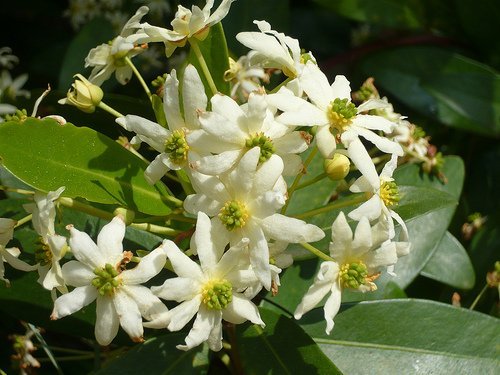Native to southeastern Australia, P. undulatum was widely introduced in the late 1800s as an ornamental tree, and it has now proven invasive in tropical, sub-tropical and warm temperate areas, especially on islands. It produces large numbers of fruits and its seeds are eaten by a wide range of frugivorous birds. It is a great colonizer of open, disturbed habitats, as well as being very shade tolerant. It is very competitive, shading out other vegetation, first invading relatively open forest and forming a dense understorey. It is especially threatening in sensitive island montane forests such as those found in the Azores, but also the Pacific islands, the South African fynbos, and even eucalyptus forests in Australia where it is considered a threat to the survival of native forests. It supports a dense soil seed bank and dense seedling recruitment and it also has a good capacity to resprout after cutting.
image source
Pittosporum undulatum is a well-defined species in the family Pittosporaceae; sub-family Pittosporeae, series Bivalvae, and is probably the most widely cultivated Pittosporum species (Cooper, 1956). There are 150-200 species of Pittosporum native to a broad area from the Canary Islands to Pacific islands via tropical Africa and the Himalayas to Japan, though most are native to Australasia where there are thought to be about 50 species (Goodland and Healey, 1996). P. undulatum hybridises naturally in its Australian native range, occasionally with Pittosporum bicolor in Victoria, and possibly also with Pittosporum revolutum further north (Cooper, 1956). There are other species within the genus that are noted as naturalizing or invasive, or potentially so, including Pittosporum pentandrum and Pittosporum viridiflorum in the Pacific (PIER, 2008), and Pittosporum tobira and Pittosporum tenuifolium in the Caribbean (Kairo et al., 2003). These species may also be possibly invasive elsewhere.


image sources
Pittosporum, from Greek, means "pitch-seed", referring to the resinous coating on the seeds. The species name undulatum is derived from the Latin unda, a wave or surge, referring to the characteristic wavy edges of the leaves.
content source
You are viewing a single comment's thread from:
